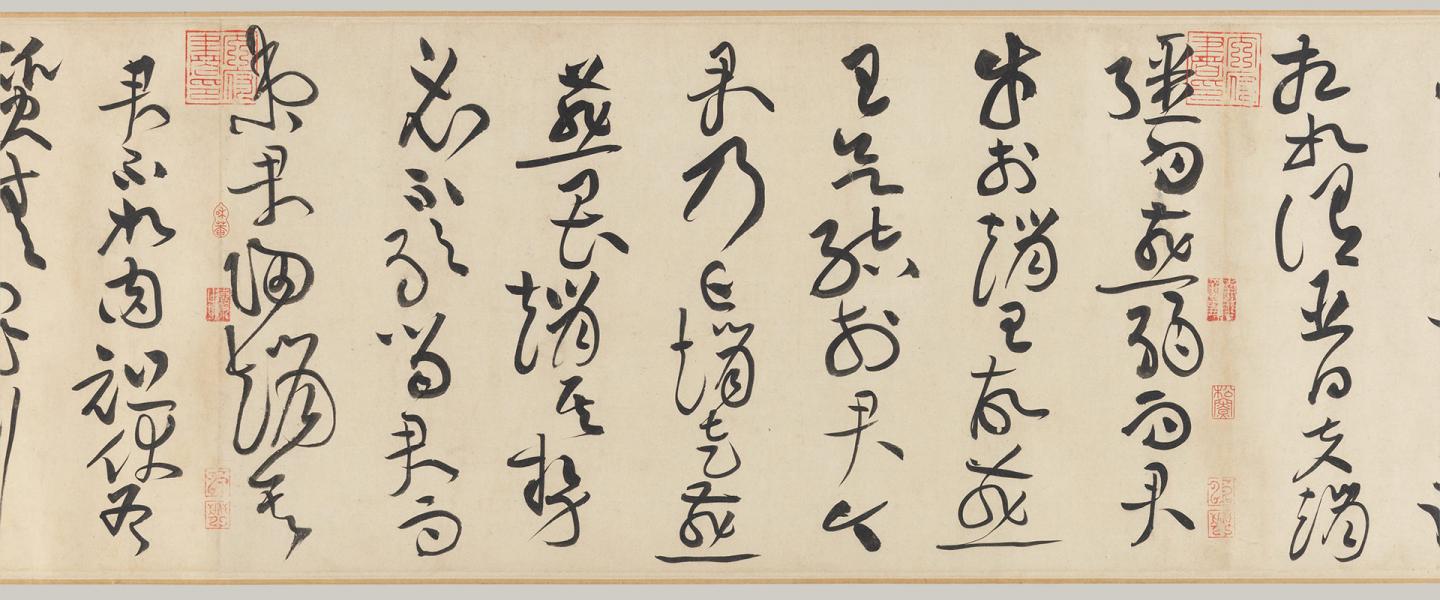Art


The Joy of Looking
The following are excerpts from the Winter 2015–16 Columbia College Today feature article “The Joy of Looking,” by Shira Boss ’93, JRN’97, SIPA’98, which profiled Robert E. Harrist Jr. GSAS’81, the Jane and Leopold Swergold Professor of Chinese Art History. Harrist is a former chair of Art Humanities and has taught the Art Humanities/Music Humanities immersion program in Paris. He is also one of the world’s foremost experts on Chinese painting and calligraphy.
“I’ve never known anybody who takes such deep and great pleasure in life — in works of art, other people, the weather — you name it,” says William Hood, visiting professor at the Institute of Fine Arts of NYU, a former colleague and longtime, close friend of Harrist. “His whole life is fueled by joy, a capacity to be awed by things most people wouldn’t even notice.”
“I still can’t believe I get paid to do this,” Harrist says. “Can you imagine anything better than being paid to look at sculptures of Michelangelo and talk about them with smart, young people? It’s impossible to describe how fortunate people in my position are — a senior position at a place like Columbia University. We are some of the most privileged people on earth.”

JÖRG MEYER
In 1978, Harrist arrived at Kent Hall for an intensive master’s in East Asian studies, then continued his art history education with a Ph.D. in Chinese art and archaeology from Princeton in 1989. He joined the faculty at Oberlin in 1987, where he remained for a decade until a position opened at Columbia. He received an Award for Distinguished Service to the Core Curriculum from the Heyman Center for the Humanities in 2004 and a Lenfest Distinguished Faculty Award in 2006.
“We have been lucky to have Bob share his expansive appreciation of art with generations of Art Hum students,” says Dean James J. Valentini. “Bob is known among students for his incredible knowledge as a professor and for encouraging them to ‘articulate the obvious’ when describing art. His passion for sharing artistic sensibilities does not stop with the visual arts. While teaching in the combined Art Humanities/Music Humanities program this summer in Paris, Bob often used his talent on the piano to play for his class the pieces they were studying in Music Hum.”
Harrist chaired the art history department from 2007 to 2011 and was a beloved leader, according to Stephen Murray, the Lisa and Bernard Selz Professor of Medieval Art History, who has been on the faculty since 1986. “He has a generosity and a civility that is so rare in academia,” Murray says. “He considered the operation as a privilege, as the creation of an ideal community of teachers and scholars, not as imposing rules and restraints. He once asked me, ‘What can I do to make your life better as a teacher?’ Has any chair anywhere ever said that?”
Can you imagine anything better than being paid to look at sculptures of Michelangelo and talk about them with smart, young people?
Robert E. Harrist Jr. GSAS’81
Nearly two decades after moving to New York, the thrill of seeing art at the Met has not worn off. Harrist goes to the museum usually once a week, often with his colleague and friend Hood. In the course of teaching art survey classes, both have lectured on Bruegel’s The Harvesters “a gazillion times,” Hood says. Yet one day they stopped to look at it together and, as Hood describes, “The next thing we knew, 1½ hours had passed.”
Another day, Harrist led Hood upstairs to look at a late-period Monet water lilies. Hood says he himself had always been prejudiced against the Impressionists, but that Harrist took him up close to the painting to examine how the color of the paint interlaced with the texture on the painting. “It was astounding. I’d never seen Monet before,” Hood says. “That’s the type of scrutiny that very few people are capable of. He’s capable of deep scrutiny, of any period, of any style, of any culture. Bob is so dedicated to the life enhancement that can come to a person who’s willing to put the effort into engaging with a work of art.”
Which is why Harrist declares Art Hum his favorite course. He teaches it nearly every year, alongside Chinese Art 101 and a graduate seminar or lecture, often on Chinese painting or calligraphy (a rare offering at U.S. schools). Even his graduate classes on Chinese art, however, are geared toward the non-specialist; he encourages students of European art to participate. “He’s a rigorous looker. He can look at a single work of art for hours and continue to come up with fresh observations,” says Joseph Scheier-Dolberg GSAS’12, assistant curator of Chinese painting and calligraphy at the Met and a grad student of Harrist. He recalls the day when Harrist put up a slide of an ornamental detail in his Chinese art class and asked if anyone could identify it. Nobody could. It was a pattern from a mosaic on the subway platform at 116th Street. “He never turns his eye off. He’s always looking,” Scheier-Dolberg says.
Harrist says that getting people truly to look is a main job in art history: “The older I get, the more I find myself focusing on that,” he says. “It’s incredibly hard to look at things. You think you’re seeing things but really your eye is just drifting.” Recently he has been examining the ways of the late Meyer Schapiro CC 1924, GSAS 1935, the preeminent art reviewer, historian and Columbia professor. Schapiro believed that to examine a work of art closely, it helped enormously to draw it. To that end, Harrist himself took up drawing about the time he became chair of the department and enrolled in classes at a studio downtown. As chair, he secured funds for students to take life drawing classes.
He says about art, “I love it more every year. Sometimes I feel I’ve only recently begun to see things myself. It makes me wonder what I was doing all those years and all I missed.”

Please log in to comment.